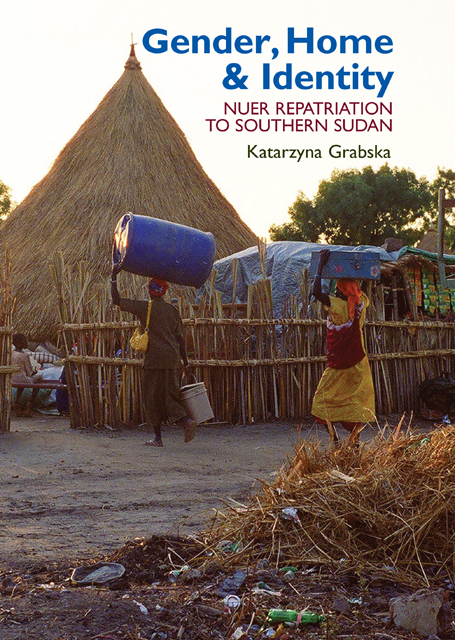Book contents
- Frontmatter
- Contents
- List of Maps and Photographs
- Preface
- Acknowledgements
- Glossary of Nuer Terms
- Acronyms
- 1 Returnee Dilemmas: Dangerous Trousers and Threatening Mini-skirts
- 2 Jiom – Season of Fighting and Running: Conflict, Mobility, Gender
- 3 Mai – Season of Displacement: Becoming ‘Modern’ in Kakuma
- 4 Rwil – Season of ‘Returns’
- 5 Season of Settling-in: Land and Livelihoods
- 6 Tot – Gendered Emplacement Identities, Ideologies and Marriage
- 7 Returnees as Visitors and the Nuer Community: Where Do We Go From Here?
- Epilogue
- Bibliography
- Index
- Eastern African Studies
3 - Mai – Season of Displacement: Becoming ‘Modern’ in Kakuma
Published online by Cambridge University Press: 24 February 2023
- Frontmatter
- Contents
- List of Maps and Photographs
- Preface
- Acknowledgements
- Glossary of Nuer Terms
- Acronyms
- 1 Returnee Dilemmas: Dangerous Trousers and Threatening Mini-skirts
- 2 Jiom – Season of Fighting and Running: Conflict, Mobility, Gender
- 3 Mai – Season of Displacement: Becoming ‘Modern’ in Kakuma
- 4 Rwil – Season of ‘Returns’
- 5 Season of Settling-in: Land and Livelihoods
- 6 Tot – Gendered Emplacement Identities, Ideologies and Marriage
- 7 Returnees as Visitors and the Nuer Community: Where Do We Go From Here?
- Epilogue
- Bibliography
- Index
- Eastern African Studies
Summary
What was life like in Kakuma? Was it life? There was debate about this. On the one hand, we were alive, which meant that we were living a life, that we were eating and could enjoy friendships and learning and could love. But we were nowhere. No matter the meaning of the word, the place was not a place. It was a kind of purgatory…
(Valentino Achak Deng cited in Eggers, 2006: 373)On arrival at Kakuma refugee camp – located in the dry savannah rangeland of Turkana nomads – one encounters football fields with crowds of multi-national refugee youth. Across the road are the high fences and barbed wire of the UNHCR compound, with its prison-like lights and security guards. ‘Welcome to Kakuma Refugee Camp!’ reads the sign on the gate to the NGO compound. Everywhere there are slogans meant to educate the residents: ‘Women rights are Human Rights’; ‘Ten days of activism against gender-violence’; ‘Women are good decision-makers’. There are constant announcements of workshops and many refugees were too busy to talk to me as they ‘have workshops’. Lony, a ‘lost boy’, described his experience after arriving in Kakuma in 1992:
When Mengistu fell and the Sudanese were expelled from Ethiopia, we arrived in Kakuma. This is where we found the real refugee life. We were put into a camp managed by UNHCR. They put all the minors under the responsibility of Radda Barnen [Swedish Save the Children], gave us food and opened a school. We were divided into groups within our communities. We first lived in Zone One, together with others [ethnic groups]. But in 1996, when the fighting between the Dinka started burning our [Nuer] homes, we ran to UNHCR. They segregated us into different zones, and Nuer got their own Zone Five.
I began to live a different life [from military life in Ethiopia]: church, school and sport. I was also a youth leader in the community and in the church from 1997. I was the deputy youth leader in the whole camp. I got a big responsibility then: catechist, altar boy, youth leader, and I was now engaged and could not do any wrong things. I became now another model in the community.
- Type
- Chapter
- Information
- Gender, Home and IdentityNuer Repatriation to Southern Sudan, pp. 64 - 103Publisher: Boydell & BrewerPrint publication year: 2014

